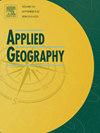Interpretable spatial machine learning for understanding spatial heterogeneity in factors affecting street theft crime
IF 4
2区 地球科学
Q1 GEOGRAPHY
引用次数: 0
Abstract
Machine learning techniques, such as random forest (RF), are increasingly utilized in geographical studies, including crime analysis. While RF excels in predictive accuracy and reduces overfitting, it does not account for spatial heterogeneity, where relationships between crime and its determinants vary by location. To address this limitation, this study utilizes a geographically weighted random forest (GWRF), which breaks down RF into local sub-models. A comprehensive set of variables is integrated to provide a thorough understanding of the factors influencing street theft crimes, including risk populations, streetscape environments, social disorganization, crime attractors and generators, and transportation accessibility. The results of the machine learning analysis are interpreted through an interpretability framework. Findings indicate that GWRF achieves greater predictive accuracy than traditional methods, reaching up to 80% accuracy on unseen data. Notably, the on-street population, derived from street view images, is the most significant contributor to street theft. Additionally, the results facilitate the examination of spatial non-stationarity concerning the importance of explanatory variables. GWRF effectively bridges machine learning and geographical models, enhancing our understanding of street theft occurrences. The local importance results enable the development of targeted safety interventions, rather than relying on general guidelines applicable to the entire region.
基于可解释空间机器学习的街头盗窃犯罪影响因素空间异质性研究
机器学习技术,如随机森林(RF),越来越多地用于地理研究,包括犯罪分析。虽然RF在预测准确性和减少过度拟合方面表现出色,但它没有考虑到空间异质性,即犯罪与其决定因素之间的关系因地点而异。为了解决这一限制,本研究利用地理加权随机森林(GWRF),将RF分解为局部子模型。综合了一套全面的变量,以全面了解影响街头盗窃犯罪的因素,包括风险人群、街道景观环境、社会混乱、犯罪吸引和产生因素以及交通可达性。机器学习分析的结果通过可解释性框架进行解释。研究结果表明,与传统方法相比,GWRF的预测精度更高,在未见数据上的准确率高达80%。值得注意的是,从街景图像中得出的街道人口是街头盗窃的最重要贡献者。此外,研究结果有助于检验解释变量重要性的空间非平稳性。GWRF有效地连接了机器学习和地理模型,增强了我们对街头盗窃事件的理解。当地重要性的结果使我们能够制定有针对性的安全干预措施,而不是依赖于适用于整个地区的一般准则。
本文章由计算机程序翻译,如有差异,请以英文原文为准。
求助全文
约1分钟内获得全文
求助全文
来源期刊

Applied Geography
GEOGRAPHY-
CiteScore
8.00
自引率
2.00%
发文量
134
期刊介绍:
Applied Geography is a journal devoted to the publication of research which utilizes geographic approaches (human, physical, nature-society and GIScience) to resolve human problems that have a spatial dimension. These problems may be related to the assessment, management and allocation of the world physical and/or human resources. The underlying rationale of the journal is that only through a clear understanding of the relevant societal, physical, and coupled natural-humans systems can we resolve such problems. Papers are invited on any theme involving the application of geographical theory and methodology in the resolution of human problems.
 求助内容:
求助内容: 应助结果提醒方式:
应助结果提醒方式:


